
Video Upload Options
Bryophyllum pinnatum, also known as the air plant, cathedral bells, life plant, miracle leaf, and Goethe plant is a succulent plant native to Madagascar , which is a popular houseplant and has become naturalized in tropical and subtropical areas. It is distinctive for the profusion of miniature plantlets that form on the margins of its phylloclades, a trait it has in common with some other members of its genus. Many people also currently call this plant Kalanchoe pinnata. It is a succulent, perennial plant, about 1 m (39 in) tall, with a fleshy cylindrical stem and a reddish color for the youngest and it flowers most of the year. The specific epithet "pinnata" is the feminine form of the Latin adjective pinnatus, meaning "winged, pinnate".
1. Description
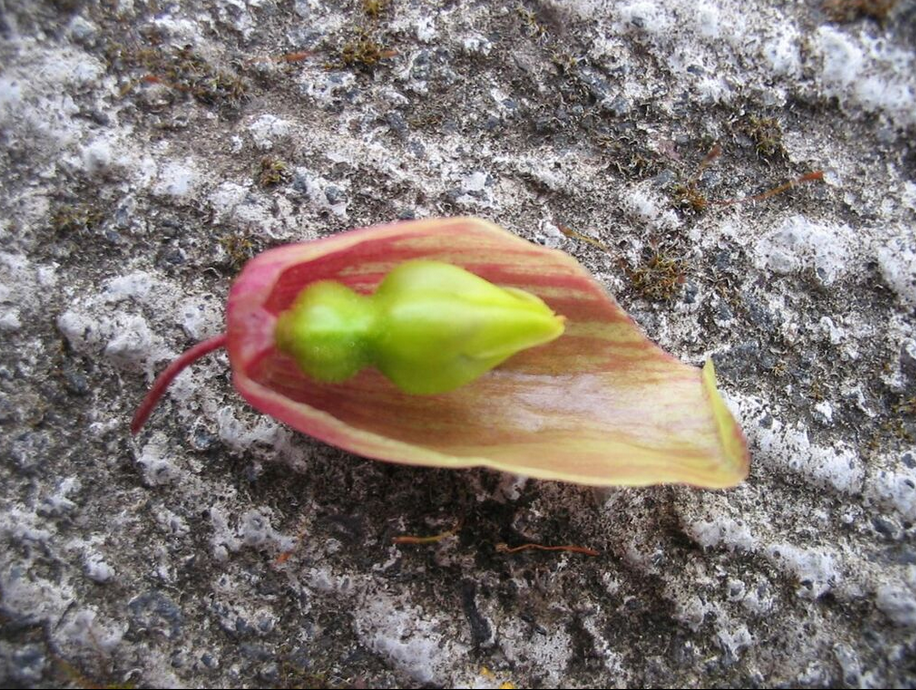
The "leaves" of this species are actually leaf-stem combinations called phylloclades. They are thick, fleshy, elliptical in shape, curved, with a crenate or serrated margin, often reddish. Simple at the base of the stem, the phylloclades are imparipinnate at the top, 10–30 cm (4–12 in) long, with three to five pairs of fleshy limb lobes.
The phylloclades are remarkable for their ability to produce bulblets. At their margin, between the teeth, adventitious buds appear, which produce roots, stems and leaves. When the plantlets fall to the ground, they root and can become larger plants. This is a fairly common trait in the subgenus Bryophyllum. The fruits are follicles (10–15 mm) which are found in the persistent calyx and corolla.[1]
The terminal inflorescence is a panicle, with many pendent, red-orange flowers. The calyx is formed of a long tube, red at the base, veined with yellowish green (or green spotted with reddish brown), with four very small triangular lobes at the end. The tubular corolla, with a pronounced constriction separating the subspherical part of the ovoid part, is terminated by four lobes which reaches 5 cm (2.0 in) in length. It is yellowish in color with red-purple streaks. The eight stamens, each about 4 cm (1.6 in) long, are in two whorls, welded on the corolla. The ovary has four carpels, slightly fused together in the center, with slender styles.[2]
2. Distribution
Bryophyllum pinnatum has become naturalized in tropical and subtropical areas, inhabiting warm and temperate climates from sea level to 2,600 m (8,500 ft), occupying sites on rock in tropical evergreen and deciduous forests, as well as montane forests. It is found in parts of Asia, Australia, New Zealand, the West Indies, the Philippines, Macaronesia, the Mascarenes, Brazil, the Galapagos Islands, Melanesia, Polynesia, and Hawaii.[3] In many of these, such as Hawaii, it is regarded as an invasive species.[4] Much of the reason for the widespread naturalization of this plant can be traced to its popularity as a garden plant.
3. Taxonomy and Nomenclature
The writer Johann Wolfgang von Goethe, who was an amateur naturalist of some repute, was "passionately fond" of this plant and liked to give the baby plantlets as gifts to friends who visited his home. He also discussed his air plant at length in an essay titled German: Geschichte meiner botanischen Studien ("History of my botanical studies").
The plant Kalanchoe pinnata was harvested by Pierre Sonnerat in Isle de France (Mauritius) and communicated to Lamarck who described it in 1786 as the Cotyledon pinnata. Subsequently, the Paris naturalist Christiaan Hendrik Persoon reclassified it in the Kalanchoe (calling it Calanchoe pinnata 1805-1807, with an orthographic variant). At the same time, in London, the botanist Richard Anthony Salisbury described the same plant from a specimen received from Bengal, under the name of Bryophyllum calycinum, and at the same time created the new genus Bryophyllum.[5]
3.1. Common Names
In Spanish it is called "Siempre Vivo", meaning Always Alive. In Tamil Nadu, it is called Tamil: ரணகள்ளி, romanized: Ranakalli. In West Bengal it is called Bengali: পাথরকুচি, romanized: Patharkuchi. It is also called "Leaf of Life" and "Wonder of the World" in the English speaking Caribbean. In Maharashtra state of india it is called Marathi: Panfuti, lit. 'whose leaves grow out from leaf').In Telugu called as రణపాల . In Odisha state of India, it is commonly known as Odia: ଅମରପୋଇ, romanized: Amarapoi, lit. 'deathless plant'. In the Philippines it is known as katakataka or kataka-taka which is an adjective meaning 'astonishing' or 'remarkable'.[6][7][8] In Sri Lanka, it is called Sinhala: අක්කපාන, romanized: Akkapäna. In Brazil it is a medicinal plant, with several common names: flor-da-fortuna, folha-da-fortuna, folha-santa, coirama, courama, saião, erva-da-costa, folha-da-costa, etc., and frequently confused (in gardening) with Bryophyllum daigremontianum, syn. Kalanchoe laetivirens.
4. Cultivation
In temperate regions, Kalanchoe pinnata is grown as an indoor ornamental plant. Like most succulents, this one does not support frost. It is advisable to leave it in an environment not descending to less than 10 °C (50 °F). It prefers a well draining ground, which prevents its roots from rotting. In the tropics, Kalanchoe pinnata is grown outdoors in gardens. It is in general, by escaping from the gardens that it becomes naturalized.
5. Toxicity and Traditional Medicine
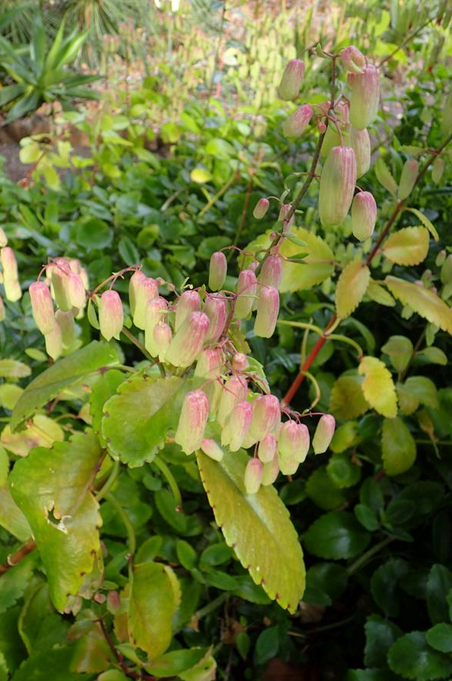
In common with other Crassulaceae (such as the genera Tylecodon, Cotyledon and Adromischus), Bryophyllum pinnatum has been found to contain bufadienolide cardiac glycosides[9] These can cause cardiac poisoning, particularly in grazing animals.[10][11]
Bryophyllum pinnatum has been recorded in Trinidad and Tobago as being used as a traditional treatment for hypertension.[12]
In traditional medicine, the juice of the leaves is also used for kidney stones, although there is ongoing research and some scientific evidence for this use but further research is required. In the French Antilles, Kalanchoe pinnata, called zeb maltet, is used in local application against headaches. For the people of the Amazon, kalanchoe has multiple uses: the Creoles use it roasted against inflammations and cancer and as an infusion, and as a popular remedy for fevers. Against headaches, Palikur rubs their forehead with a mixture of kalanchoe leaf juice with coconut oil.[13]
5.1. Chemical Constituents
Bufadienolide compounds isolated from Bryophyllum pinnatum include bryophillin A, bersaldegenin-3-acetate, and bryophillin C.[14] Bryophillin C also showed insecticidal properties.[15]
Phytochemical studies of Kalanchoe pinnata have identified the presence of triterpenes, steroid, phenanthrene, flavonoid, flavones, chalcones, taraxasterol, aurones, phenolic acid, caffeic acid, syringic acid, malic, oxalic, ferulic acid and organic acid. Bufadienolides and phenanthrene are toxic compounds. Two calves fed for 48 hours with K. pinnata have been reported to have died due to ataxia and severe cardiac arrhythmia.[16]
6. Gallery
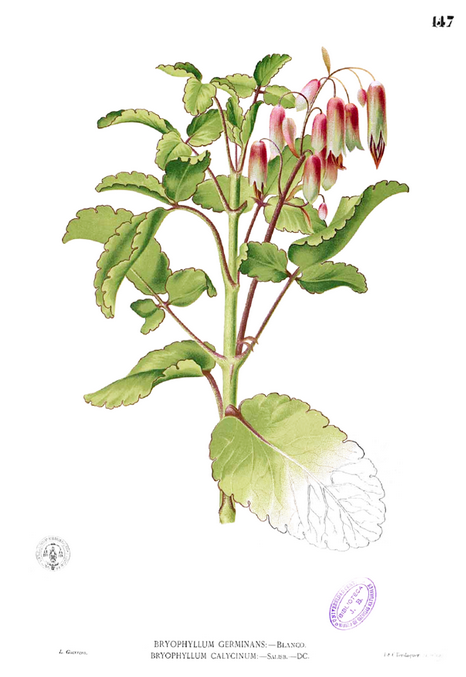
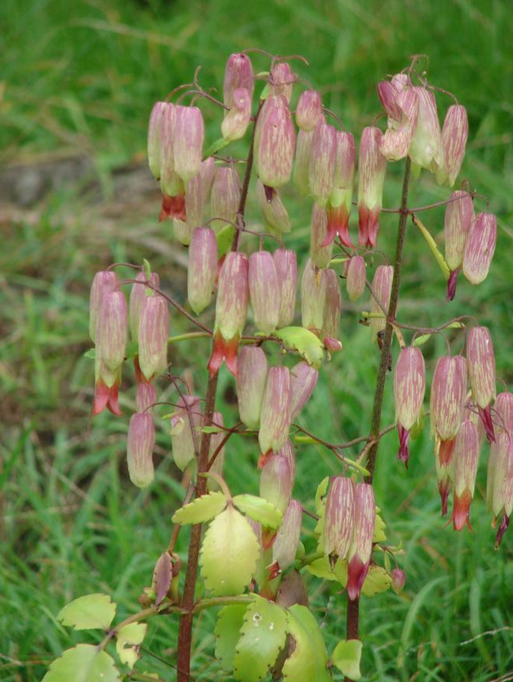
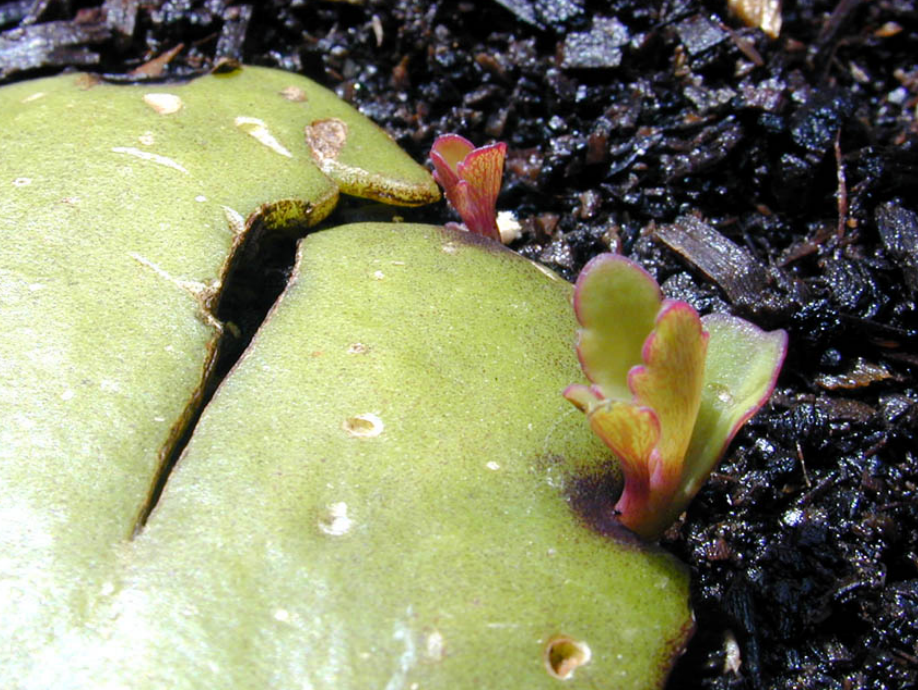
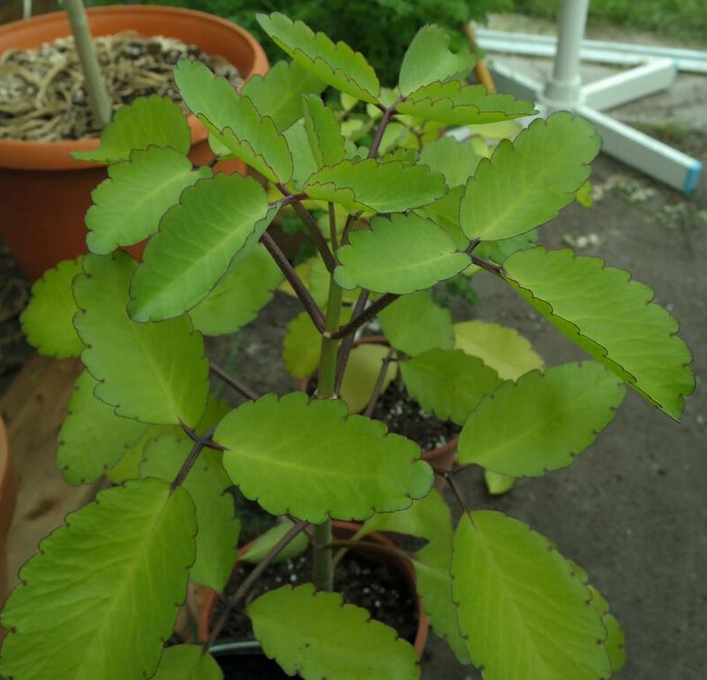
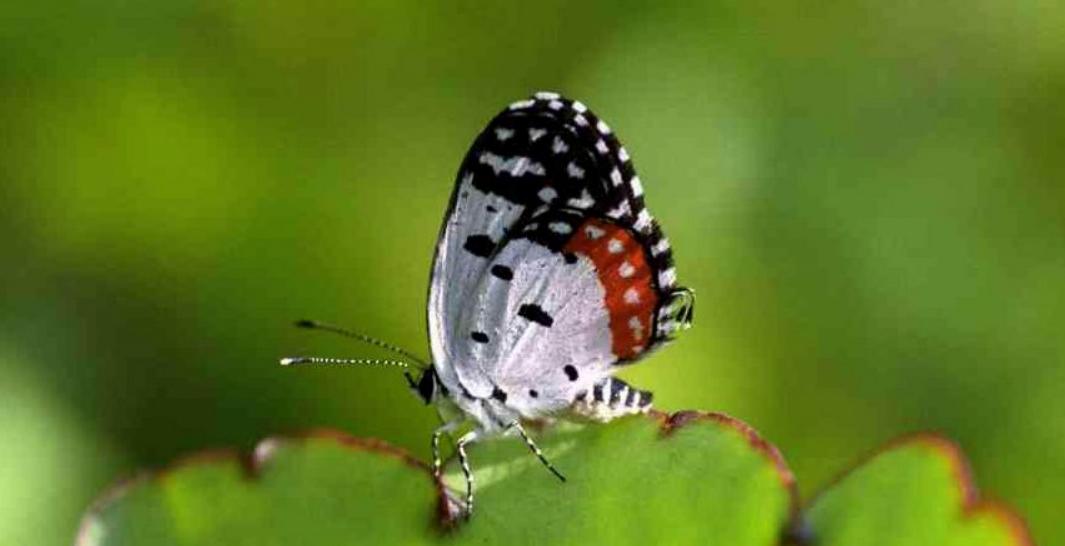
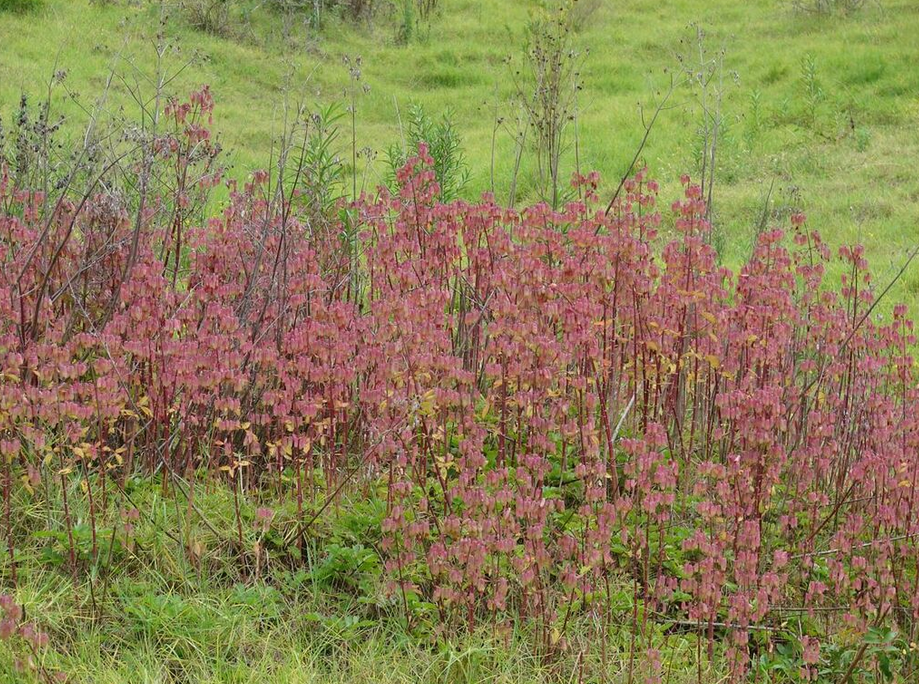
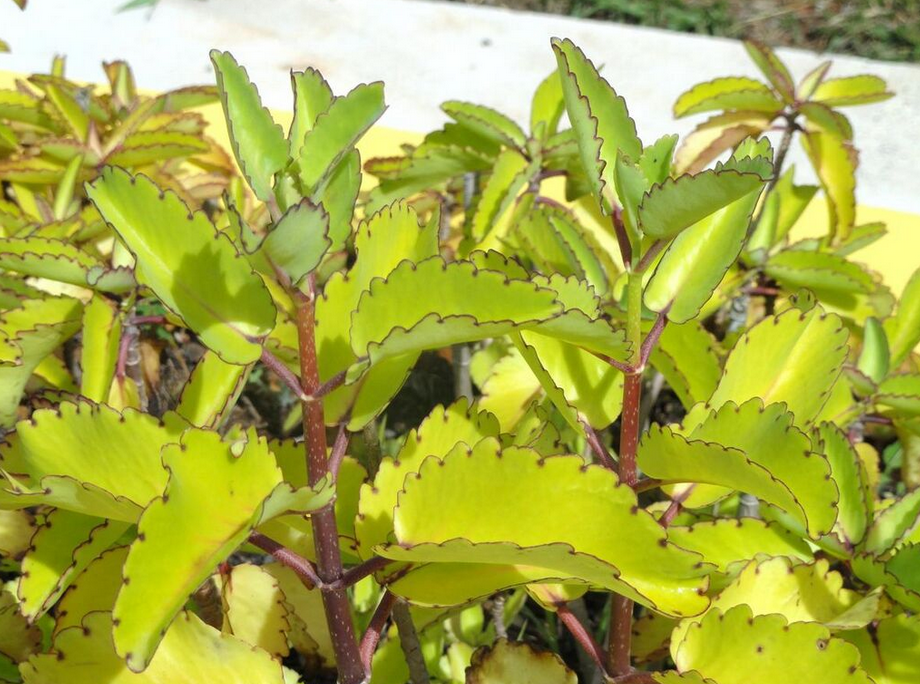
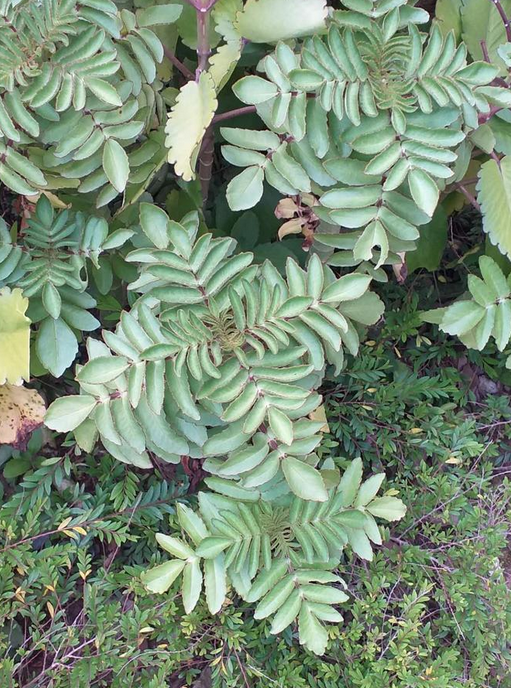
References
- Kamboj Anjoo, Ajay Kumar Saluja," Microscopical and Preliminary Phytochemical Studies on Aerial Part (Leaves and Stem) of Bryophyllum pinnatum Kurz." PHCOG J., Vol. 2, n° 9, 2010, p. 254–9
- Batygina, T. B.; Bragina, E. A.; Titova, G. E. (1996). "Morphogenesis of propagules in viviparous species Bryophyllum daigremontianum and B. calycinum". Acta Societatis Botanicorum Poloniae 65: 127. doi:10.5586/asbp.1996.022. https://dx.doi.org/10.5586%2Fasbp.1996.022
- {{citation | mode = cs1 | title = Kalanchoe pinnata | work = Germplasm Resources Information Network (GRIN) | url = https://npgsweb.ars-grin.gov/gringlobal/taxonomydetail.aspx?21076 | publisher = [[Organization:Agricultural Research ServAgricultural Research Service (ARS), United States Department of Agriculture (USDA) | access-date = 2007-10-01 }}
- "Kalanchoe pinnata". Hawaii's Most Invasive Horticultural Plants. Archived from the original on 2007-11-03. https://web.archive.org/web/20071103170324/http://www.state.hi.us/dlnr/dofaw/hortweeds/species/kalpin.htm. Retrieved 2007-10-01.
- V. Hequet Mr Le Corre, F. Rigault V. Blanfort " Invasive alien species of New Caledonia ", Southern Province Convention , vol. C153-08,2009
- "Katakataka". Philippine Medicinal Plants. http://www.stuartxchange.com/Katakataka.html. Retrieved 2008-11-20.
- "Kataka-taka". Filipino Herbs Healing Wonders. Archived from the original on October 17, 2008. https://web.archive.org/web/20081017204349/http://www.filipinoherbshealingwonders.filipinovegetarianrecipe.com/herbs_pics/katakataka.php. Retrieved 2008-11-20.
- "Katakataka It usually used as a medicine to cure kidney stone.". Tagalog English Dictionary. http://www.bansa.org/dictionaries/tgl/?type=search&data=katakataka. Retrieved 2008-11-20.
- Steyn, Pieter S; van Heerden, Fanie R. (1998). "Bufadienolides of plant and animal origin". Natural Product Reports. Royal Society of Chemistry. http://www.rsc.org/delivery/_ArticleLinking/DisplayArticleForFree.cfm?doi=a815397y. Retrieved 2007-09-19.
- McKenzie RA; Dunster PJ (July 1986). "Hearts and flowers: Bryophyllum poisoning of cattle". Aust. Vet. J. 63 (7): 222–7. doi:10.1111/j.1751-0813.1986.tb03000.x. PMID 3778371. https://dx.doi.org/10.1111%2Fj.1751-0813.1986.tb03000.x
- McKenzie RA; Franke FP; Dunster PJ (October 1987). "The toxicity to cattle and bufadienolide content of six Bryophyllum species". Aust. Vet. J. 64 (10): 298–301. doi:10.1111/j.1751-0813.1987.tb07330.x. PMID 3439945. https://dx.doi.org/10.1111%2Fj.1751-0813.1987.tb07330.x
- Lans CA (2006). "Ethnomedicines used in Trinidad and Tobago for urinary problems and diabetes mellitus". J Ethnobiol Ethnomed 2: 45. doi:10.1186/1746-4269-2-45. PMID 17040567. PMC 1624823. http://www.ethnobiomed.com/content/2//45.
- Hermann Jacobsen : The Succulent Encyclopedia . 3. Edition. Fischer, Jena 1983, p. 275.
- Supratman U; Fujita T; Akiyama K et al. (April 2001). "Anti-tumor promoting activity of bufadienolides from Kalanchoe pinnata and K. daigremontiana x tubiflora" (PDF). Biosci. Biotechnol. Biochem. 65 (4): 947–9. doi:10.1271/bbb.65.947. PMID 11388478. http://www.jstage.jst.go.jp/article/bbb/65/4/947/_pdf.
- Supratman U; Fujita T; Akiyama K; Hayashi H (June 2000). "New insecticidal bufadienolide, bryophyllin C, from Kalanchoe pinnata" (PDF). Biosci. Biotechnol. Biochem. 64 (6): 1310–2. doi:10.1271/bbb.64.1310. PMID 10923811. http://www.jstage.jst.go.jp/article/bbb/64/6/1310/_pdf.
- Bernard Descoings: Kalanchoe pinnata . In: Urs Eggli (ed.): Succulent lexicon. Crassulaceae (thick-leafed plants) . Eugen Ulmer, Stuttgart 2003, ISBN:3-8001-3998-7 , p 175




